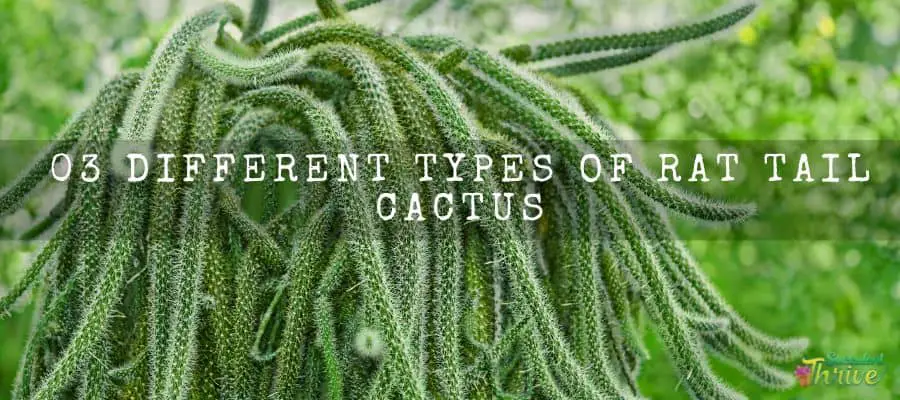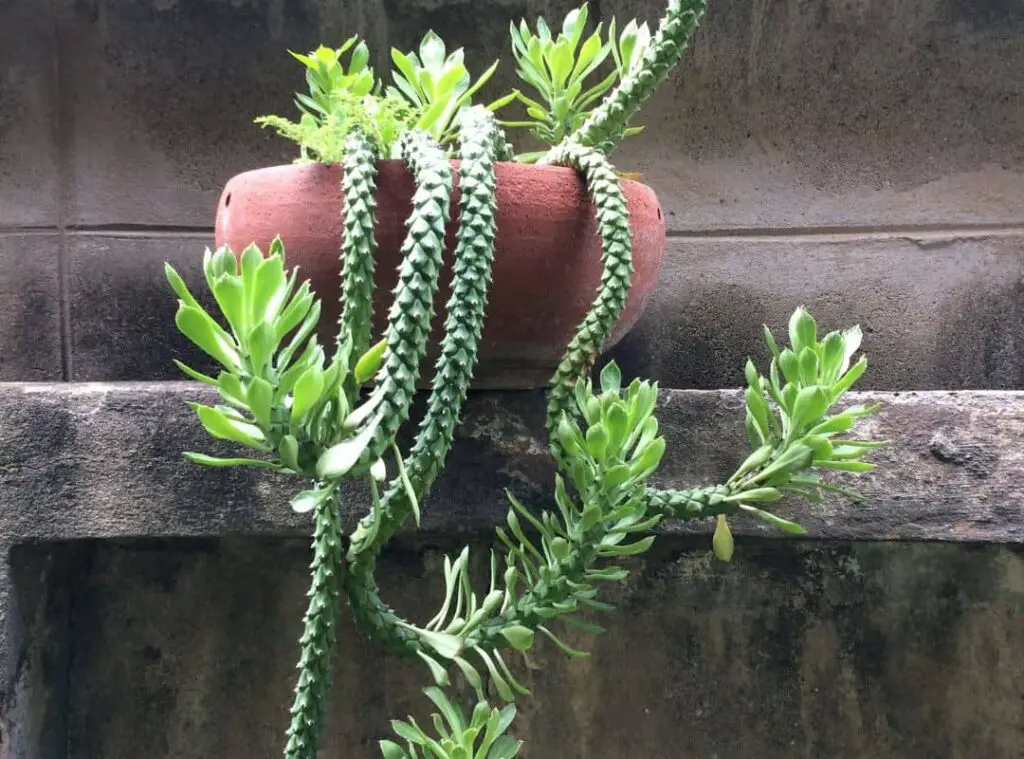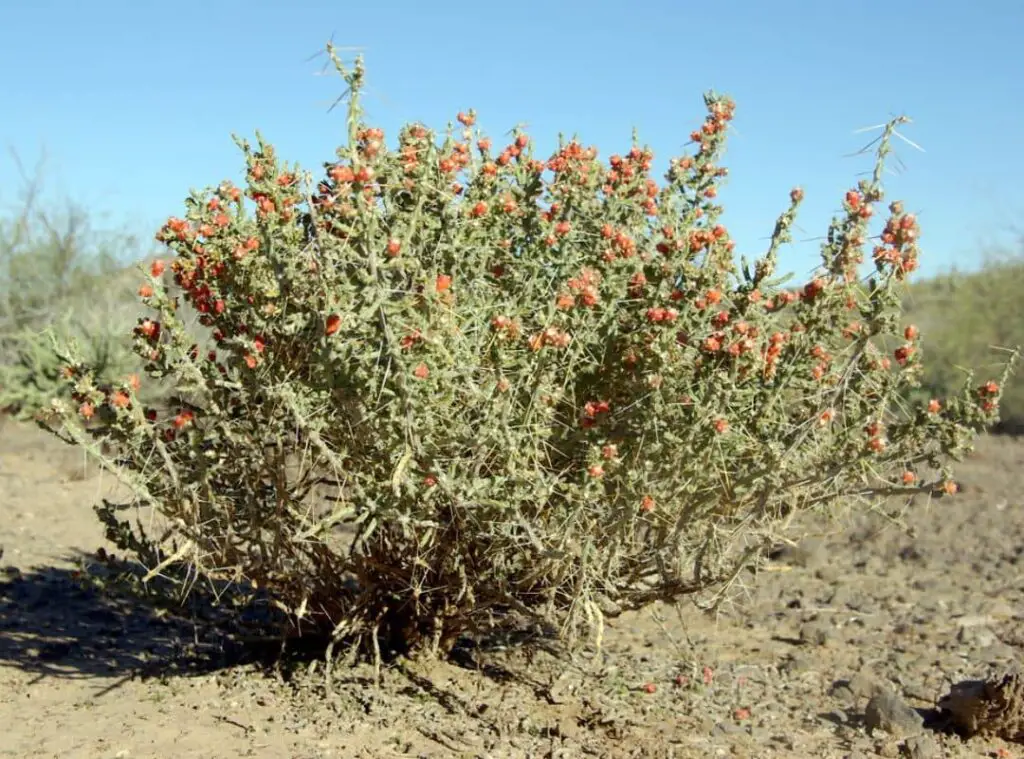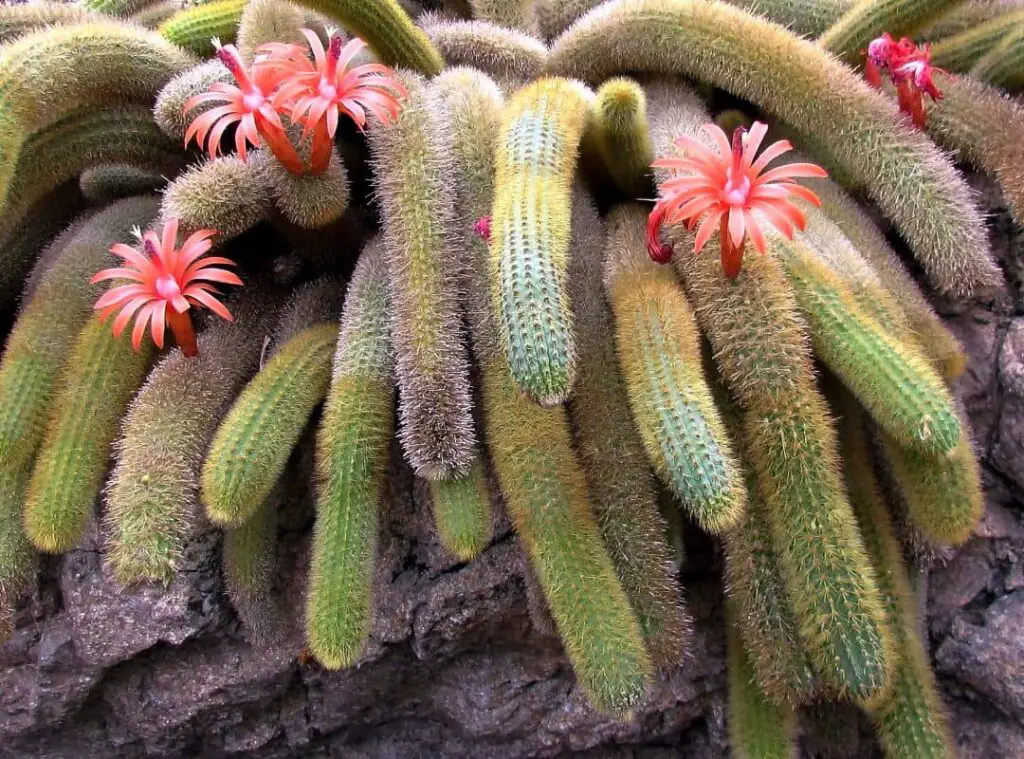Have you ever come across a cactus which resembles a rat tail? If the answer is yes you probably know about the rat tail cactus. Then you should know there are few different types of rat tail cactus in the world. In fact, growing rat tail cactus as an indoor plant has become a trend all over the world recently.
So, to briefly touch on their origin, they are native plants in Mexico and categorized as an endangered cactus plant. The botanical name of the rat tail cactus is aporocactus flagelliformis. Rat tail cactus has several varieties. So, keep on reading this article further to learn on them.

Disocactus flagelliformis (Aporocactus flagelliformis)
Usually these rat tail cactus in their natural habitat would form as trailing or pendant. Further you may spot them forming in epiphytic style over rocks or even in trees when they grow in their natural habitat.
Their stems would be bright green in color and they would consist of 8-12 narrow low ribs. Further you could spot those ribs carrying spines as well. Moreover they would be about 3 mm in length. In terms of flowering, you could spot them producing flowers in crimson, pink colors.
They would be tubular shaped. You may spot them flowering in the spring season and it would last for a couple of months approximately. Further, the lifetime of the individual flowers would be only several days.

Size of Disocactus flagelliformis
Their stems would be pendant, and they could be about 1.5 meters in length. On the other hand, their thickness would be about 2 cm as they grow within two years. When it comes to the sizes of the flowers, they would be about 5 cm in length and 2.5cm in width when they mature.
Where to place (indoor or outdoor)
You could easily grow them as indoor plants. Having said that, they could grow outdoors too. Rat tail cacti are a fast growing set of plants. These cacti would be a perfect fit for hanging baskets. Moreover, you could consider growing them by a window also.
USDA Growth Zone
Rat tail cactus preferred hardiness zones are 10a- 11.
Special care tips
In terms of caring tips, you need to make sure that you provide the following growing conditions.
Light requirement – you need to make sure that you provide full sunlight for them. When you hang the baskets, always select a bright sunny spot to hang them.
It could be a bright sunny window in most cases. You can be tactful in planting it outdoors during summer so that it could gain fresh air as well as adequate sunlight.
Temperature – You may plant the rat tail cactus at room temperature during their active growing season. When it comes to the winter season, it is best to make them rest at temperature range of 7-10 degrees Celsius (45-50 degrees Fahrenheit).
Having said that, they could also withstand temperatures up to 15-16 degrees Celsius. (59-61 degrees Fahrenheit).
Water – You may water the rat tail cactus abundantly during their active growing season. That would allow the soil medium to remain moist.
However, do not let the cactus stand in water though. When it comes to watering them in the winter season, it is best to skip watering them mostly since they can dry out then.
Fertilizing – I would recommend applying a half strength liquid fertilizer on the stems of the cactus. You could do this once every two weeks during their growing season. Avoid feeding them during the winter season.
Potting and repotting – when you choose the potting medium ensure that you select a potting medium which is a blend of two thirds of soil-based mixture and one third of leaf. Instead of leaf, you may also use old milk cow manure. If not, you could also use commercial orchid compost.
When it comes to repotting, it is best to repot them annually simply because they are fast growing cacti.
Further you need to select a slightly larger pot when repotting. Ideal time to do repotting is right after flowering. you need to repot them as then you could provide nutrients freshly.
Cylindropuntia leptocaulis
You could mainly identify the Cylindropuntia leptocaulis by looking at their thin stems. They have the thinnest stems of all cholla. They are half an inch across. However, their sharp and chubby spines may be more than 2 inches in size.
Usually they will have one spine in white or in golden brown per areole. You may further spot them forming in a downward angle. Having said that, most of these plants would not have spines also.
Their stems could be pale green mostly. Having said that you could spot them in purple as well. Further they would be smooth and would not have pronounced tubercles as well. You could commonly spot them in countries such as America and in Mexico.
The flowering of the rat tail cactus cactus would also help you to identify them. Those flowers would be yellow and small. Further they would form fruits which are bright red in color. They would stay alive throughout midwinter.

Size of Cylindropuntia leptocaulis
Those plants would grow in shrub type, and they would be about 4 feet in height. They tend to grow as low shrubs and look for larger shrubs for their safety.
Where to place (indoor or outdoor)
cylindropuntia leptocaulis would be suitable for indoor gardening and would be handy for xeriscaping as well.
USDA hardiness Zone
Cylindropuntia leptocaulis preferred zones would be USDA zones 9b – 11.
Special care tips
Basically, you need to ensure that you are properly watering them. In fact you need to avoid over watering since it could create worse repercussions as these are drought tolerant plants.
When it comes to sunlight requirements, they would love to grow under full sunlight. Further, you may grow them in a soil mix which has a wide array of ph. It could be mildly acidic, neutral, or even mildly alkaline.
Cleistocactus winteri (Golden rat tail)
Among Different Types Of Rat Tail Cactus You could identify Cleistocactus winteri by looking at the columnar ribs they form. Further they have a tangled look as well. Apart from that they would further consist of spines as well.
Their blooming would also help you to identify these cacti as they form orange or salmon pink flowers. You could spot them flowering in late winter to early spring.
Not only that but also, they produce a fruit which you could spot in green or in red color. They would be barrel shaped and could be about 1 cm in length.
Golden rat tail cactus are endemic plants in Bolivia. Further you could spot them in some parts of America as well. They are regarded as an endangered species. These cacti grow rapidly.

Size of Cleistocactus winteri
Chances are that they could grow to 1 meter in height and 6cm in diameter. Golden rat tail cactus could form about 16-17 ribs, and they would further carry spines which could be over 50. Those spines would be about 1 cm in length.
Where to place (indoor or outdoor)
You could grow them as outdoors plants as well as indoors plants. You could grow these in hanging baskets when you grow them as indoor plants. If you have grown them as outdoor plants, it is best to shift them indoors when the temperature drops.
USDA hardiness Zone
Golden rat tail cactus preferred USDA zones are 9a – 11b.
Special care tips
You need to provide filtered bright sunlight, partial sunlight, or light shade. However, do not expose them to intense full sunlight as it would create sunburns then.
In terms of watering them, it is best to water them moderately during their growing season. You could do that once a week during the summer season. Always let the soil become dry before you water them again. Skip watering them during the winter season.
I would urge you to feed them with a high potassium liquid fertilizer occasionally during their growing season. In addition to that do not forget to use a well-draining soil mix as well.
You need to consider repotting them every other year as they are fast growing cacti. Further you need to consider repotting as they would require a lot of space for the roots to spread out and grow.
As such whenever you see your cactus had outgrown from the pot, you need to consider repotting them. Further it would allow the cactus to gain nutrients swiftly and freshly when you repot them in a fresh soil mix.
Further when you repot them it would allow you to inspect the root system of the plant . In fact you could identify if there are any root rots in the plant. When you spot any damaged root parts or dead root parts, you can remove them then and there.
This cactus has several stems and chances are that some of those stems could wither and perish naturally. As such you need to inspect your cactus on a constant basis and take off whatever the dead parts of the plant you spot.
when you do that, it would stimulate the new growth of the cactus. Their stems are fragile and could be easily broken. Hence handle the plant with care.
Related questions
How do you identify a rat tail cactus?
Rat tail cactus inherit a unique and attractive appearance. You could spot the cactus in green when they are immature and young in age. However, they could turn beige once they grow older. The significant highlight of these cacti are their long trailing stems.
Can a rat tail cactus take full sun?
Rat tail cactus cannot take full sunlight. Instead, Rat tail cactus would love to grow under indirect bright sunlight.
How long does it take for a rat tail cactus to grow?
Rat tail cactus would usually grow one foot taller for one year.
How often does rat tail cactus bloom
You could spot them blooming from spring to early summer.
Conclusion : Different Types Of Rat Tail Cactus
I hope you would have realized that rat tail is such a wonderful plant to have around, and it would add so much glamor to your landscape once you grow them.if you are a beginner in gardening, you could consider growing these cacti.
Read Next : Sea Dragon Succulents |Truly Amazing Succulent|


